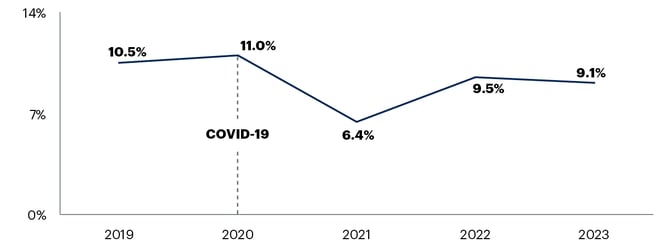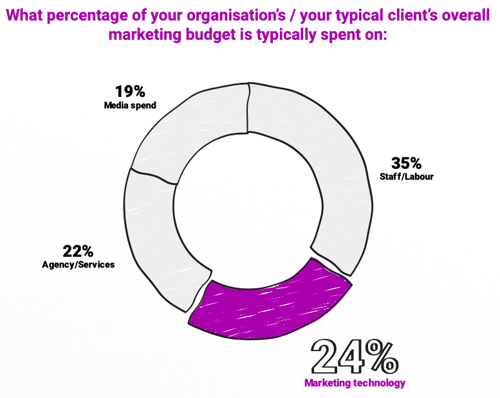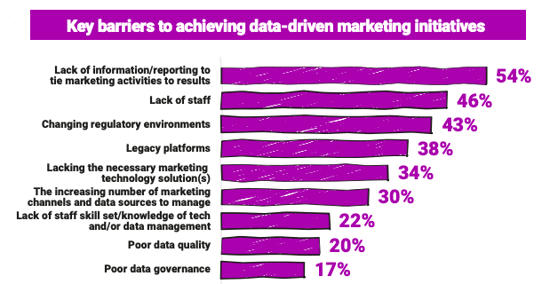Pressure on budgets is normal for any CMO or marketing leader, but current economic conditions mean that demands to do more with less are louder than ever before.
Recent data from Gartner suggests that the CMO's spending power is being squeezed to the extent that many feel they may be unable to execute their strategy in 2023.
Gartner's survey found that marketing budgets sit at an average 9.1% of overall revenue, down from 9.5% last year.

Spending on technology is under pressure, with 75% of marketers report being under pressure to cut martech spending this year to deliver better ROI.
Gartner's data echoes findings from research we carried out recently, for our new State of Data-Driven Marketing Report. 59% of CMOs we surveyed agreed that their marketing and data tech spend is coming under more pressure than ever before.
This is to be expected, with martech accounting for almost a quarter of the typical marketing budget.

While Gartner puts some blame on CMOs and their tendency to become 'attracted to the allure of newer technologies', one key issue may be the challenges faced in proving the impact of investment made in martech, and therefore justifying their budgets.
The issue of proving ROI can be tricky. For 54% of CMOs we surveyed recently, the ability to tie marketing activities to business results was a key challenge when looking to achieve data-driven marketing.

This ability to connect tech investment to business outcomes is essential for marketers to justify tech budgets, and can become even more vital in periods when budgets are under pressure.
As Christine Bailey, Senior Director & Head of KYC Marketing, Europe & Africa, Moody’s Analytics, told LXA:
"With increasing pressure on marketing budgets, data is vital to ensure we are spending our money wisely. The best marketers are able to make a connection between marketing inputs and metrics that relate to reach (top of the funnel), response (middle of the funnel) and revenue (bottom of the funnel)."
Under-utilisation of technology is another issue cited, with utilisation rates falling from 58% in 2020 to 42% in 2022. Essentially, this means that markers aren't necessarily using the features of the tech tools they have to their full extent.
Under-utilisation may not be a problem, if the tool is delivering value. This is a question we asked Scott Brinker in a 2021 interview:
"I think everyone would agree at this point the utilisation rate (of tech) is probably quite low. I don't think that's the right metric though. It doesn't matter how much functionality a particular piece of software has, what matters is that the functionality that I choose to use is effective for me and is getting me results.
There's always some additional functionality that could be useful, and perhaps I should invest time in learning that. However, just because some piece of software has a feature, does that mean you should use it?
I think the fact that some functionality in a particular tool goes unused by a particular company isn’t necessarily a bad thing as long as it's effective overall."
Under-utilisation is often the nature of tech tools. For example, a digital commerce platform may come with analytics features or email marketing capabilities which are already present in other tools in the tech stack. If these extra features remain unused, it doesn't necessarily mean marketers aren't seeing value from the platform.
However, if under-utilisation is a consequence of a lack of skills and knowledge, then this is an issue which may need to be addressed through training.
It may also be that there are some unused features which may help marketers make the most of existing budgets, so it's important for marketing teams to audit their tech to assess the capabilities that currently exist.
AI is a good example here. The growth of OpenAI and recent rapid advances have made this a go-to for marketers, but there are already plenty of AI capabilities in many marketing tech stacks.
Auditing current tools, capabilities, and utilisation can help marketers to identify features and functionality which match AI use cases. Training around marketing technology may also be needed to understand features and drive adoption.
With budgets under greater pressure, CMOs can make their case more forcefully through the ability to prove ROI and impact on business revenue, while they can identify and unlock potential features by reviewing their current tech capabilities.
Hey there, martech fans. Want to expand your knowledge on the space to the nth degree? Well, have we got a treat for you. Be the best martech-er you can be, and continue your learning journey, with our 4Ps ebook here!
